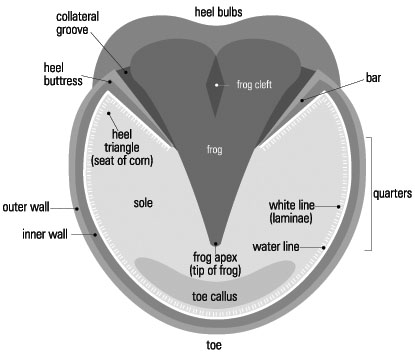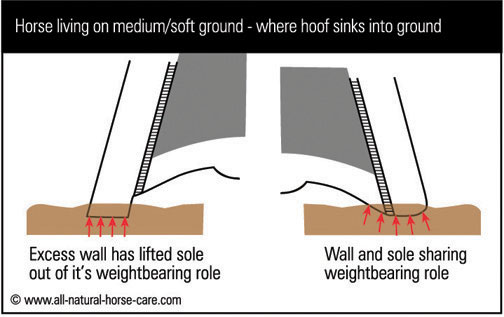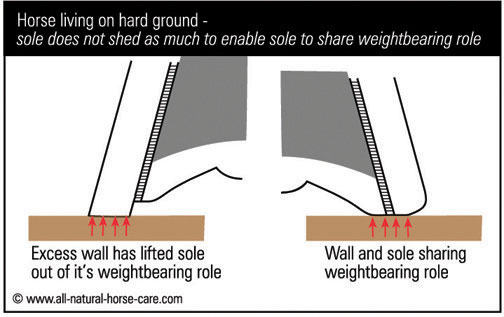Jenny Edwards at www.all-natural-horse-care.com has some really great barefoot and natural hoof care information. There are pictures and diagrams to help you with knowing all the different parts of a hoof.
Barefoot Hoof
Below are some barefoot hoof diagrams to give you an idea of what the shape of the “ideal” hoof should look like. The parts of the hoof are labeled for reference.
Note: Healthy hooves can vary depending on the environment the horse is living in and the terrain they regularly encounter.
Sole View of a Front Hoof

Note the following points
- Wide, fat frog.
- Tight white line.
- Strong, thick hoof walls – with the inner wall being thicker.
- Bars end approximately halfway down the frog.
- The heel buttresses are back towards the rear of the frog.
- The hoof ratio is 65:35 (from the rear of the hoof to the widest point; and from the widest point to the break over).
Sole View of Rear Hoof

The rear hoof is more oblong in shape and has a slightly pointed toe compared to the front hoof. This is because the rear hooves are used to propel the horse forward and so the point helps the hoof dig into the ground to provide more push.
Side View of the Hoof

Weight bearing – The True Role of the Wall And Sole
Contrary to popular belief, the hoof wall should not be the only structure to bear the weight of the horse. This is called peripheral loading and it puts way too much stress on the laminar connection and has a dramatic effect on the blood supply to the hoof. Dr Robert Bowker VMD, PhD recently did research on this and found that on a:
- Correctly trimmed Bare foot: blood flow continues between heartbeats
- Shod foot: blood stops between heartbeats and blood does not reach small blood vessels.
- Laminitic foot: blood stops and backs up between heartbeats
The diagrams below show how the hoof should be trimmed (images on right hand side of box) so that both the wall and the sole bear weight.


All horse owners should have this knowledge and study the hoof to know what is what in that hoof! Then when your trimmer/farrier pays your horse a visit, you will know what he/she is talking about or referring to when they discuss the horses’ hoof. You can be more knowledgeable and be able to ask questions of your trimmer/farrier.
The use of EasyCare Comfort Pads in your EasyCare boots will ensure that the hooves are not being peripheral loaded. Our hoof pads come in three densities…soft (green), medium (black) and firm (red). The thicknesses are 12mm (1/2″) or 6mm (1/4″). Our Easyboot Glove boots will only accommodate the 6mm pads so the close fit is not compromised.
Nancy Fredrick






Since you show these drawings here on your blog, I assume that EasyCare sees this as the hoof form to aim for.
Both hooves depicted here are wider than they are long (measured as you would for fitting a boot). However, the vast majority of your boots are longer than they are wide – sometimes by quite a bit – and will not fit the hoof form shown here.
Any plans to cater for horses with round hooves in the near future? (And I’m not talking Old Macs here!)
Manu
Comments are closed.